Contents
Eye diseases in rabbits, if they are not a symptom of an infectious disease, are no different from eye diseases in other mammals, including humans. Up to the point that the eye of a rabbit can be examined and diagnosed by an ophthalmologist.
If conjunctivitis is a symptom of an infectious disease in a rabbit, it is pointless to treat it without eliminating the underlying cause. In this case, first of all, the disease is treated, and in relation to the eyes, symptomatic treatment is used, aimed at alleviating the well-being of the rabbit.
Diseases of rabbits related only to the eyes, most often have a hereditary nature. May be due to mechanical damage, chemical eye irritation, or dacryocystitis, which usually results from congenital malposition of rabbit molars.
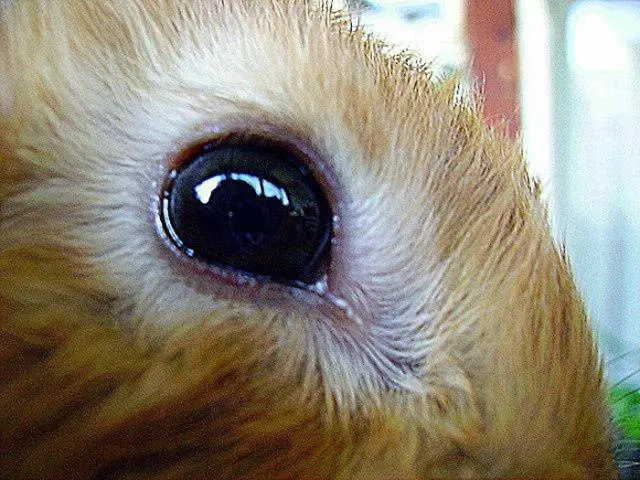
Eye diseases of an infectious nature should be considered in conjunction with the treatment of the underlying disease in a rabbit, so it makes no sense to dwell on them in this case.
Non-infectious eye diseases in rabbits are generally treated in the same way as in other animals. The difference is only in size.
Mechanical and chemical damage to the eyes of rabbits and their treatment
Mechanical damage to the eyes of rabbits occurs as a result of fights between animals, pricking the eye with senink during feeding, bruises, if, when frightened, the rabbit stumbles on the corner of the feeder or other object.
Such damage usually resolves on its own, although the eye can look creepy. Often in this case, there is profuse lacrimation from the eye. The eye is closed. There may be swelling of the eyelids.
To prevent a secondary infection in this case, drops with a broad-spectrum antibiotic can be dropped into the rabbit’s eye.
Chemical eye irritation in a rabbit can only be caused by ammonia fumes from decaying urine in an uncleaned cage. In this case, not medical, but sanitary measures are needed.
If the eyes are clogged with earth or lime from the walls, the eyes of the rabbit are washed with saline. If the eyes of the rabbit were washed out almost immediately after contamination, then no other measures are required. Otherwise, drops with an antibiotic are instilled.
A rabbit’s eyes may begin to water due to an allergic reaction. In this case, no eye treatment will help until the allergen is identified and eliminated.
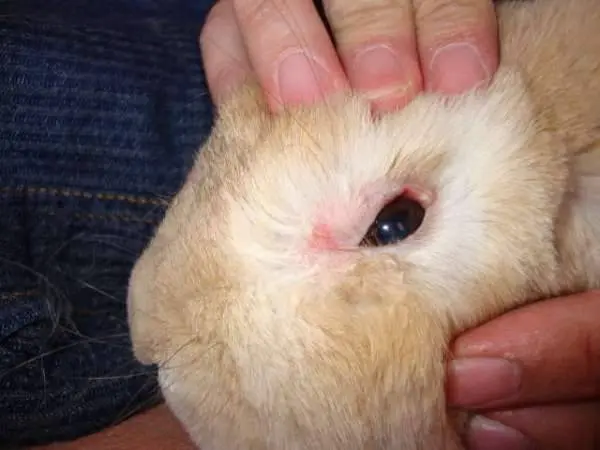
Such hay is often called dusty due to the fact that when shaken, a lot of dust rises into the air, which is actually mold spores. These same spores often cause respiratory infections in rabbits.
To eliminate the problem and prevent an allergic reaction in a rabbit, such hay will have to be shed for at least 10 minutes.
Conjunctivitis with beriberi
A lack of vitamins can also cause conjunctivitis in a rabbit. There is such conjunctivitis with a lack of vitamins A or B₂. To eliminate the cause, it is enough to add the missing vitamins to the rabbit’s diet and further monitor the usefulness of rabbit food.
The situation is worse if rabbit eye diseases are caused by hereditary factors or are a complication after other diseases.
Dacryocystitis
An eye disease that is congenital in nature, as it occurs with improper growth of the molars, which change the shape of the nasolacrimal canal. As a result, at first the eye begins to water, since the secretions of the lacrimal gland do not have the opportunity to get through the nasolacrimal canal into the nose. The clogged channel becomes inflamed. Later, when a secondary infection sits on the inflamed surface, the outflows become purulent.
Treatment is possible only by surgery, as it is necessary to remove incorrectly growing teeth. The operation is carried out in a veterinary clinic. Accordingly, the treatment of dacryocystitis is possible only for decorative rabbits. It is easier for a farmer to kill such a rabbit.
After the removal of an abnormally growing tooth, the nasolacrimal canal is cleaned. In advanced cases, drainage is required. Since neglected cases automatically imply festering and infection of the canal, eye drops with an antibiotic are used to eliminate a secondary infection.
In the photo, the drainage of the nasolacrimal canal, popularly called the “cloud”.
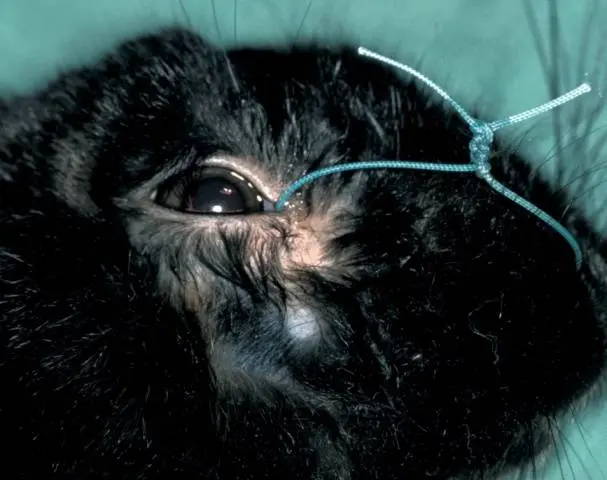
The principle of operation is simple: periodically it is necessary to pull the cord back and forth to clear the channel and get rid of dried mucus.
Inversion of the eyelids
The scientific name is entropium. Occurs as a complication after keratitis. Moreover, the entropium itself can be the cause of secondary keratitis. Other causes of entropium: cartilage deformity, prolonged conjunctivitis, hereditary predisposition.
Inversion of the eyelids in a rabbit can also occur with convulsive contraction of the circular muscle of the eye.
When the eyelids are inverted, the eyelashes get caught between the eyelid and the cornea of the eye, damaging it and causing keratitis. If you start the problem, it is possible to perforate the cornea.
The torsion is eliminated only by surgery. If eye drops do not help a rabbit with conjunctivitis for a long time and the eye continues to fester, you should consult a doctor. Maybe it’s not the usual conjunctivitis.
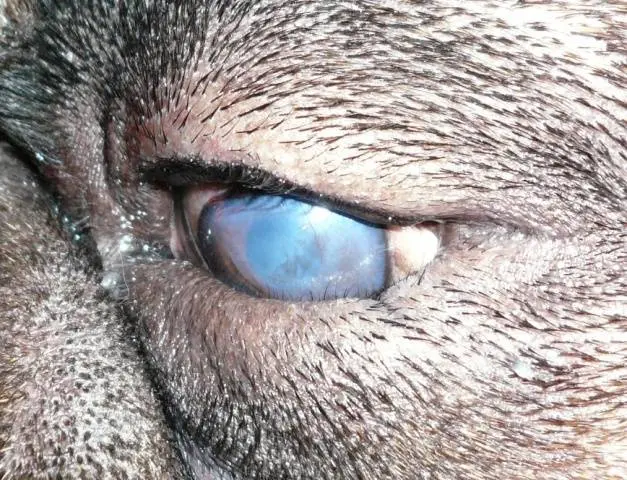
Eyelid eversion
The reasons are almost the same as for volvulus, only instead of convulsive contraction of the muscle, one of the reasons is paralysis of the facial nerve.
Eyelid ectropion is characterized by drooping of the eyelid and its separation from the eyeball. As a hereditary factor, it is often found in dogs with a crude constitution (mastiffs), but in rabbits this phenomenon is very rare and such rabbits should not be allowed to breed.
Much more often, eyelid eversion in rabbits occurs due to fights or as a complication after an illness.
The eversion of the eyelids is also eliminated surgically.
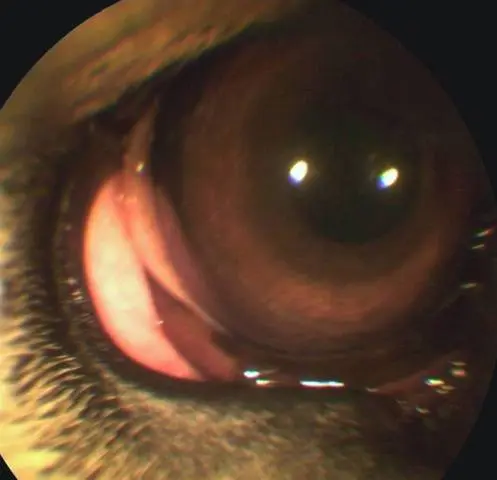
The last of the diseases related to the eyelids is blepharitis.
Blepharitis
This is an inflammation of the eyelids that can lead to eversion or drooping of the eyelids. Blepharitis can be superficial or deep. The cause of blepharitis in both cases are:
- mechanical damage, i.e. burns, wounds, bruises;
- irritation of the eyelids due to chemical, thermal or mechanical effects, that is, sunburn, contact with a caustic substance on the eyelids, scratching are possible.
It is possible to distinguish between superficial and deep blepharitis by external signs.
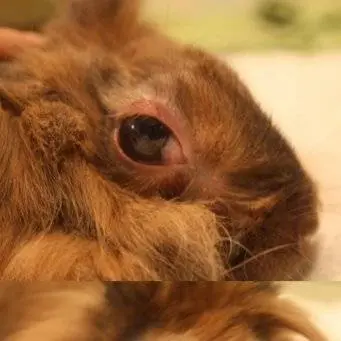
Superficial blepharitis has 3 stages:
- Eyelids itch and redden;
- The edges of the eyelids thicken, scales of dead skin appear on the eyelids, the eyelashes fall out, the palpebral fissure is narrowed, redness of the conjunctiva is observed;
- Ulcerative blepharitis develops; pustules form in place of the eyelashes, after opening they turn into sores. The ciliary edge is wet and bleeding.
Deep blepharitis has no stages. This is an extensive purulent inflammation of the tissue of the eyelids, without the main localization of the abscess in one place. Eyelids very swollen, painful. The eye is closed. Pus flows from the inner corner of the eye. The conjunctiva swells and protrudes into the palpebral fissure.
Treatment of blepharitis
With superficial blepharitis, lotions from a 1% solution of baking soda can be used. The edges of the eyelids are treated with antimicrobial ointments: furatsilin or svfatsil sodium.
As a general remedy, antibiotics and sulfonamides are used. The same drugs are used in the treatment of deep blepharitis. In the event of the appearance of localized abscesses, they are opened.
Conjunctivitis
The general name of the inflammatory processes in the mucous membrane between the eyelid and the eyeball.
The causes of conjunctivitis in rabbits can be mechanical and chemical factors. Mechanical include irritation of the eye with dust or a piece of hay that has fallen on the mucous membrane. To chemical: caustic agents, disinfectants, lime dust, acids, alkali, ammonia in poorly ventilated areas.

The symptoms of conjunctivitis are the same:
- itching;
- blepharospasm, that is, spontaneous closing of the eye;
- photophobia;
- discharge from the inner corner of the eye;
- eyelid soreness.
Discharge from the eyes with conjunctivitis may be clear or purulent. The latter usually occurs either with an underlying infectious disease or with advanced non-contagious conjunctivitis.
There are 5 forms of conjunctivitis:
- acute catarrhal conjunctivitis;
- chronic catarrhal conjunctivitis;
- purulent conjunctivitis;
- fibrinous conjunctivitis;
- follicular conjunctivitis.
In acute conjunctivitis, lacrimation, photophobia, redness of the mucous membranes of the eye are observed. If you do not treat acute conjunctivitis, it will turn into chronic with purulent discharge.
Often, conjunctivitis is provoked by pathogenic microflora that has “sunk down” on damage to the mucous membrane or has taken advantage of the weakened immunity of the rabbit.
Treatment of conjunctivitis
First of all, the cause of conjunctivitis is eliminated. The eyes are washed with weak disinfectant solutions: potassium permanganate or furacilin. For catarrhal conjunctivitis, astringent solutions are recommended, of which boric acid is the most famous and widespread. The eyes are washed with a 3% solution of boric acid.
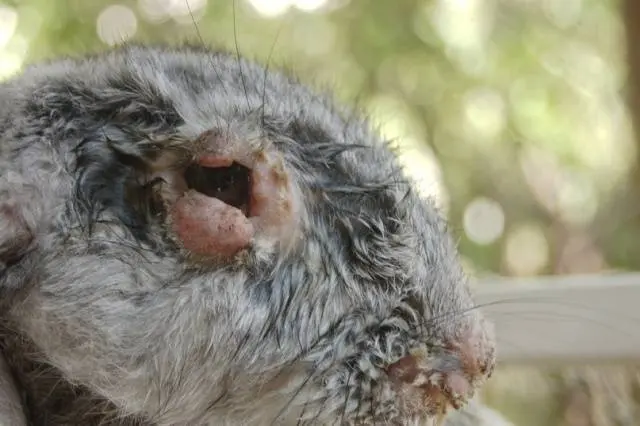
In purulent forms, intramuscular injections of antibiotics are used to destroy pathogenic microflora. For topical use, eye ointments and drops with broad-spectrum antibiotics are used.
Keratitis
Inflammation of the cornea of the eyeball. The causes of the disease are the same as those of conjunctivitis.
The main symptom of keratitis is clouding of the cornea. With purulent keratitis, the turbidity will be yellow. In addition to turbidity, there is photophobia, exfoliated particles of the epithelium, germination of the cornea with additional blood vessels.
Treatment of keratitis
Eliminate the cause and prescribe eye ointments or drops with antibiotics.
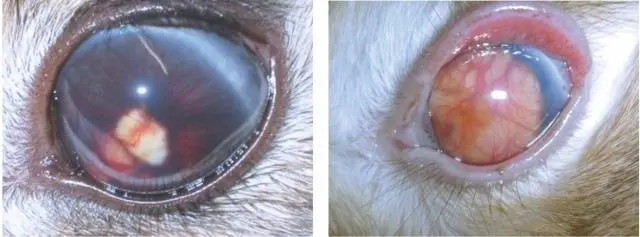
Corneal ulcer
Ulcers occur with glaucoma, lack of lacrimal fluid with blockage of the nasolacrimal canal, lesions of the facial nerve.
An ulcer is a perforation of the cornea of the eye. Surgery is usually required to remove the eyeball.
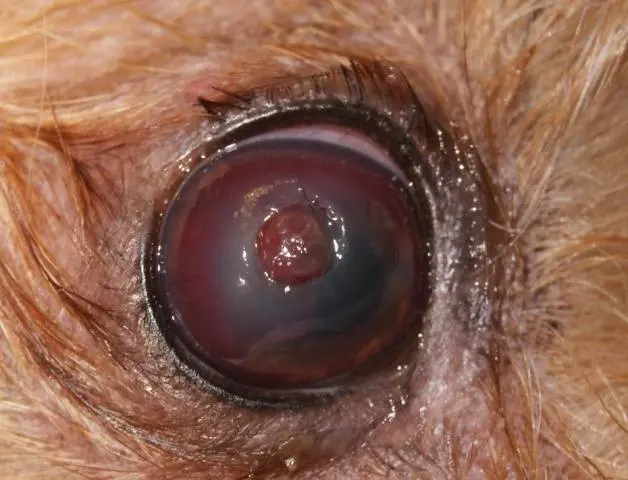
Uveit
Usually this is a concomitant underlying disease. Occurs with advanced keratitis or corneal ulcer, as well as with infectious diseases. In fact, uveitis is an inflammation of the choroid of the eye. Treat the underlying disease.
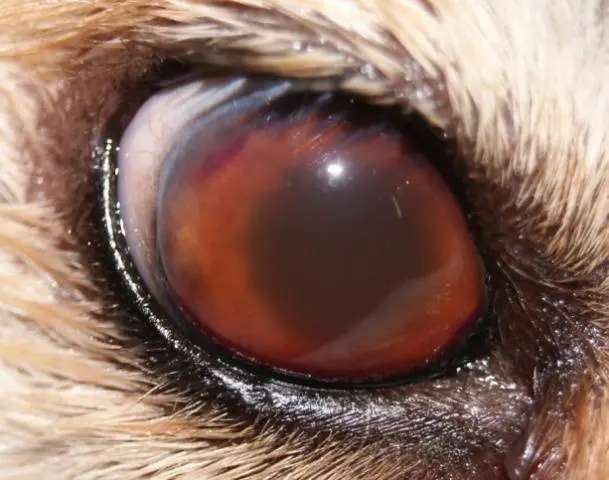
Conclusion
All eye diseases of rabbits require professional medical intervention. Treatment of eye diseases in productive rabbits is usually not cost effective, except for mild forms of conjunctivitis. Whether to treat decorative rabbits is usually decided by the owners, depending on their capabilities.









